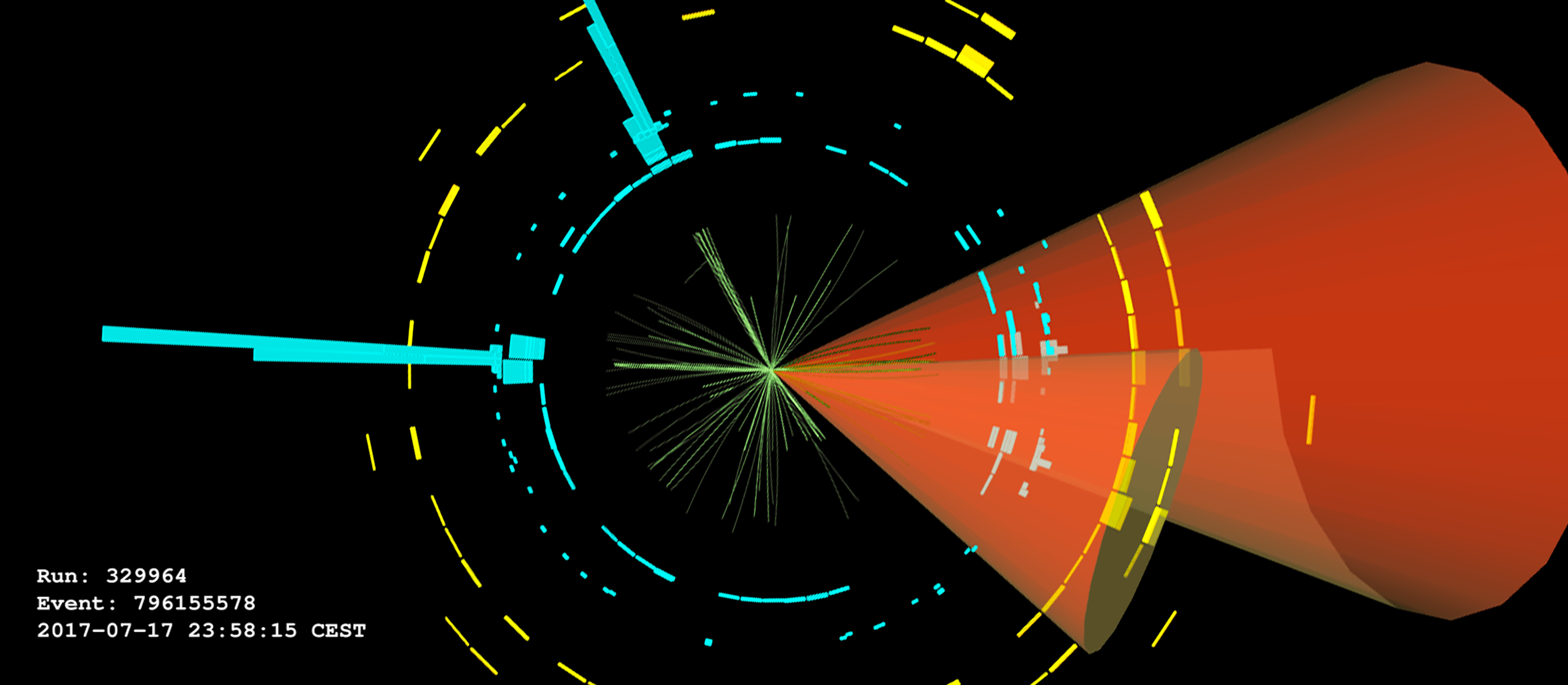ATLAS dives deeper into di-Higgs: a combined search
6 June 2024 | By
Two Higgs bosons appearing in the same proton collision is much more than a simple coincidence. Studies of this process, known as “di-Higgs” production, allows physicists to measure the strength of the Higgs boson’s “self-coupling” – a fundamental aspect of the Standard Model that connects the Higgs mechanism and the stability of our Universe.
However, measuring di-Higgs production is an especially challenging task. It’s a very rare process, about 1000 times rarer than the production of a single Higgs boson. During Run 2 of the LHC (2015-2018), only about 4000 di-Higgs events are expected to have been produced, compared to the 40 million collisions that happened every second.

So can physicists find these rare needles in the data haystack? To maximise their chances, researchers study the most promising decays of the two Higgs bosons. The most probable way two Higgs bosons decay is into four bottom quarks (HH → bbbb). However, many other processes also create four bottom quarks in a collision, thus this signature has the highest likelihood of being mimicked by other Standard-Model processes (“background”). The di-Higgs decay to two bottom quarks and two tau leptons (HH → bb𝜏𝜏) has moderate background interference but is five times less common and has neutrinos that escape undetected in the final state, complicating physicists’ ability to reconstruct the di-Higgs decay fully. By contrast, the di-Higgs decay to two bottom quarks and two photons (HH → bb𝛾𝛾) is one of the rarest accessible decay modes, but the presence of two photons makes it clearly identifiable in the ATLAS detector. There’s also the di-Higgs “soup” to consider, where two Higgs bosons leave a multi-lepton signature in the detector. Finally, another rare decay mode is the di-Higgs final state containing two bottom quarks, two leptons, and neutrinos (HH → bbll+ETmiss).
Each of these decay modes has its pros and cons, and all have sensitivity to di-Higgs production. What if physicists could combine their power to achieve a more sensitive result? In a new analysis from the ATLAS Collaboration, physicists merged five di-Higgs studies of LHC Run 2 data. By combining the power of all these decay channels, researchers achieved the most sensitive probe of di-Higgs production and the Higgs self-coupling. These new determinations provide crucial information to help theoretical physicists in developing new models.
The ATLAS Collaboration merged five analyses to achieve the most sensitive probe yet of di-Higgs production and the Higgs self-coupling.
Achieving this combined result required a careful study of all the analyses, ensuring the statistical models were compatible and that none of the selected ATLAS events overlapped between channels. Though ATLAS physicists had previously performed a combination of di-Higgs analyses in 2021, this new combination includes, for the first time, the multi-lepton and bbll+ETmiss decay channels, as well as improvements to analyses of the other channels. This new result is thus stronger and more comprehensive, covering over half of all possible di-Higgs decays.
The analysis excludes di-Higgs production cross-section values that are more than 2.9 times larger than the Standard-Model prediction (Figure 1). Researchers also constrained, relative to the Standard Model prediction, the magnitude of the Higgs self-interaction (κλ) and the interaction strength of two Higgs bosons and two vector bosons (κ2V). This is shown in Figure 2, where κλ is constrained between -1.2 and 7.2, and κ2V between 0.57 and 1.48. Both measurements are consistent with the value of 1 which corresponds to the Standard-Model predictions.


Physicists also considered how physics beyond the Standard Model would affect di-Higgs production. Using the “Effective Field Theory” approach, physicists predicted that new interactions, like the one between two Higgs bosons and two top quarks (ttHH) or two gluons (ggHH), would appear in the data. This latest analysis sets the most stringent constraints on the strength of these interactions, as shown in Figure 3. The observed data are in tension with the Standard Model, with a probability that the results could have occurred by chance (p-value) of 3.1%.
This combined result sets a milestone in the study of di-Higgs in Run 2 data, providing the best-yet sensitivity to the strength of the Higgs boson self-coupling. Now, ATLAS researchers set their sights on data from the ongoing LHC Run 3 and upcoming High-Luminosity LHC operation. With these, physicists will at last observe these elusive Higgs-boson pairs.
Learn more
- Combination of searches for Higgs boson pair production in proton-proton collisions at 13 TeV with the ATLAS detector (ATLAS-CONF-2024-006)
- LHCP2024 presentation by Arely Cortes Gonzalez: Non-resonant di-Higgs searches and measurements with the ATLAS detector
- Probing new physics with pairs of Higgs bosons, ATLAS Physics Briefing, July 2021
- Search for pair production of boosted Higgs bosons via vector-boson fusion in the bb¯bb¯ final state using proton-proton collisions at 13 TeV with the ATLAS detector (Phys. Rev. D 108, 052003, arXiv:2404.17193, see figures)
- Two Higgs bosons are better than one, ATLAS Physics Briefing, July 2021
- Search for the non-resonant production of Higgs boson pairs via gluon fusion and vector-boson fusion in the bb¯τ+τ− final state in proton-proton collisions at 13 TeV with the ATLAS detector (arXiv:2404.12660, see figures)
- Shedding light on Higgs-boson self-interactions, ATLAS Physics Briefing, September 2023
- Studies of new Higgs boson interactions through nonresonant HH production in the bb¯γγ final state in proton-proton collisions at 13 TeV with the ATLAS detector (JHEP 01 (2024) 066, arXiv:2310.12301, see figures)
- Search for non-resonant Higgs boson pair production in the 2b+2ℓ+ETmiss final state in proton-proton collisions at 13 TeV with the ATLAS detector (JHEP 02 (2024) 037, arXiv:2310.11286, see figures)
- Menu of the day: Di-Higgs soup!, ATLAS Physics Briefing, April 2024
- Search for non-resonant Higgs boson pair production in final states with leptons, taus, and photons in proton-proton collisions at 13 TeV with the ATLAS detector (arXiv:2405.20040, see figures)




